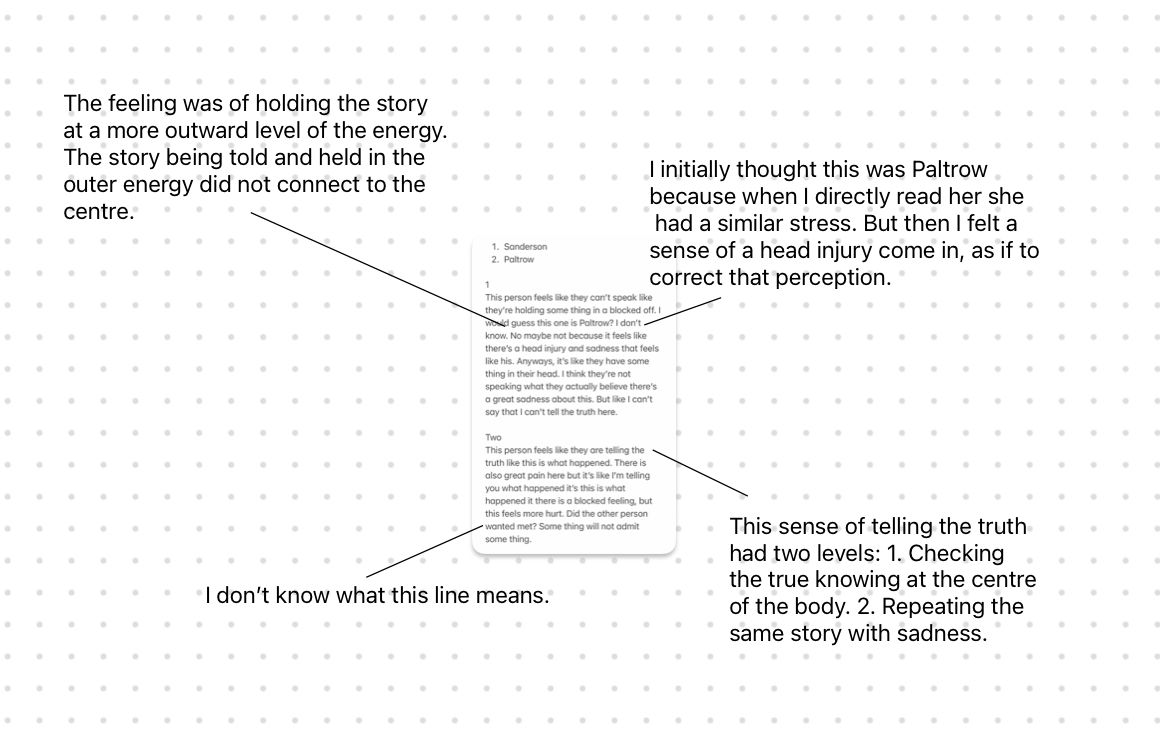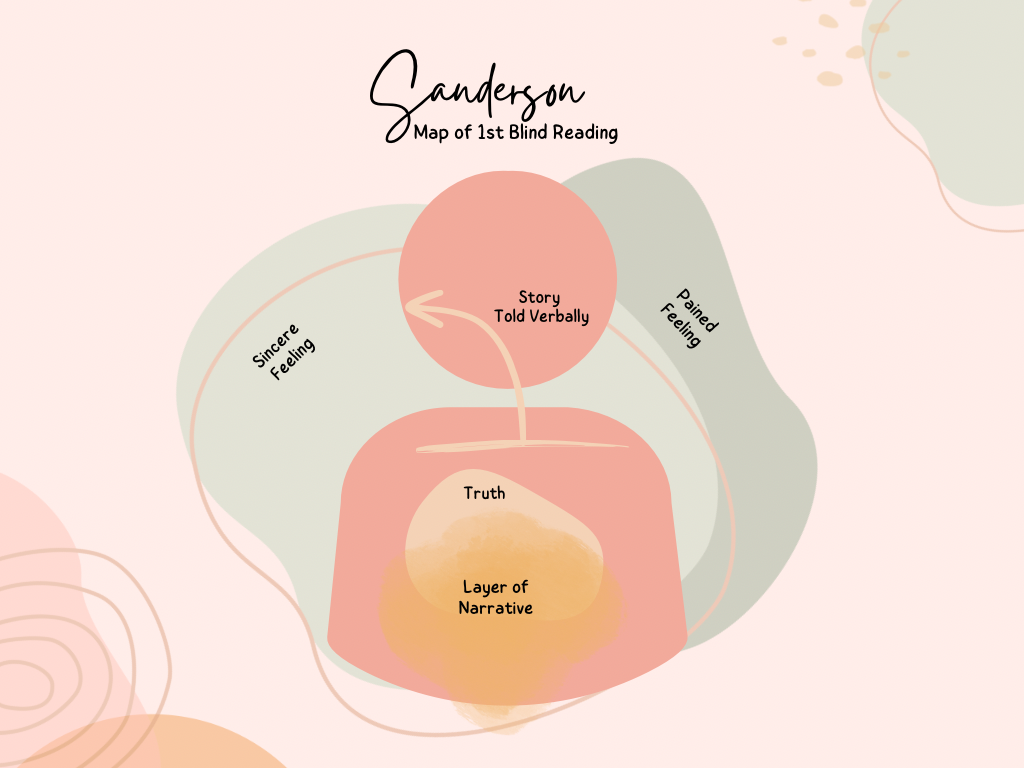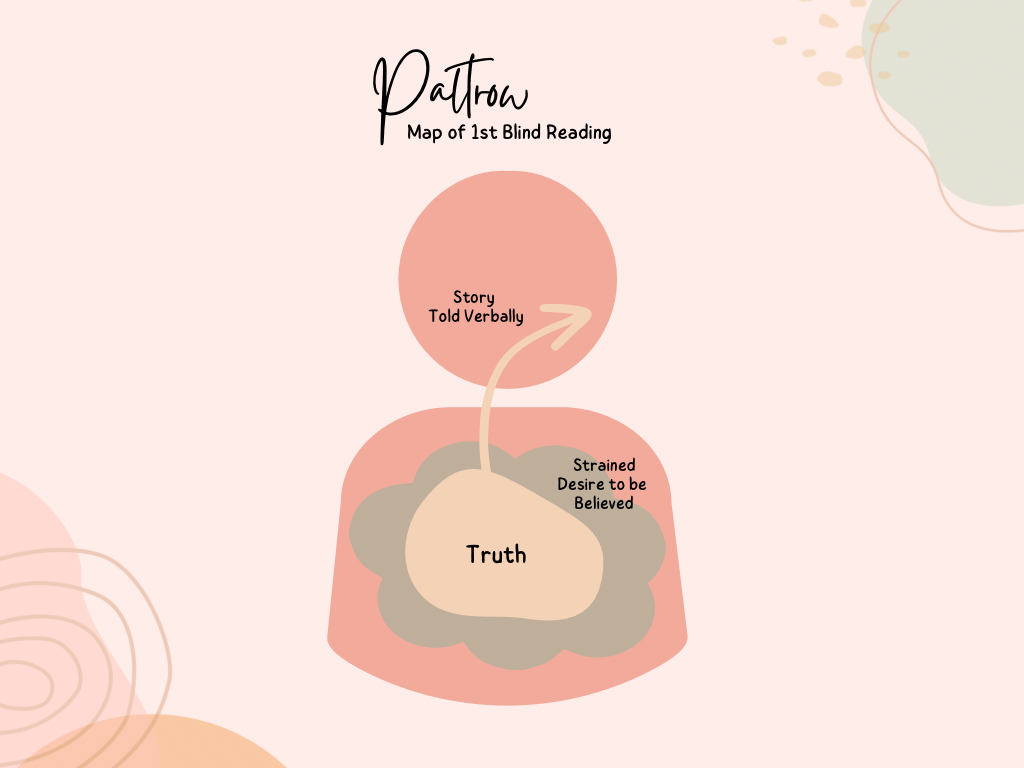Tracing Reality by Feel
A beat-by-beat account of reading Paltrow and the man suing her. CW: gun violence

A Psychic-Intuitive Exploration of Truth in the Gwyneth Paltrow Skiing Case
When I came across the Gwyneth Paltrow skiing case, I was curious. The famous actress Gwyneth Paltrow was being sued for skiing into an optometrist and injuring him, but she claimed that, in fact, he’d skied into her. It was a case in which not only responsibility, but the essential facts of what happened were disputed. Someone had to be not only lying, but inventing a whole sequence of events. The mechanics of this kind of fabrication fascinate me.
For some, the case was a great opportunity to rediscover that lawyers can be hot, and muse on Gwyneth Paltrow’s infamous “unrelatability,” but like many people I was most interested in whether the celebrity known for controversial truth claims was telling the truth or not. Unlike most people, I read people for a living and I have systematic, if unusual, approach for looking into these things.
As a professional psychic with a particular ability to tune into and describe people, I tell other people about themselves and people whom they know but I don’t and they say “wow,” “yes,” “spot on,” and, my personal favourite, “I knew that, but I’ve never put it into words before.”
In this line of work, I spend a lot of time describing the personalities of people, including people I’ve never met, don’t know the names of, and have never so much as seen a picture of. I talk to strangers about their families and loved ones as if we’ve both known them for years. I give detailed accounts of how people process internally and why that leads to the kind of interactions they have with others. I can do this so well that people ask me to explain to them their own parents, romantic partners, siblings, and even themselves.
Taking Inner Experience Seriously
I am perpetually interested in people and what is going on in their inner and outer lives. In addition to my professional practice, reading people is a big part of how I personally navigate the world. I use my psychic and intuitive insight into people to determine how to relate to them, what to expect from them, and what to believe about them. So, when I heard via an instagram meme that Gwyneth Paltrow was being sued, I decided to read the situation to determine what I should believe.
This is a beat-by-beat account of my process. It tells a strange kind of story. I won’t be discussing the details of the case. All of the readings were completed before the trial was decided, but I didn’t watch any of the trial and my knowledge of the case is admittedly superficial. This is entirely a story of my internal experiences.
The basic premise of what I do is that the inner worlds of people are meaningful and informative in ways that provide insight not just into the individual themselves, but into other people and the world around them. In other words, psychic readings are possible and by tuning into my own inner experience I can learn real things about other people and situations I have nothing to do with.
This controversial claim underlies everything I am about to describe. Without this premise, the following is nothing more than an account of a person having a series of thoughts and feelings about other people and taking those experiences way too seriously. However, if you do take the premise seriously, it opens the door to a whole set of questions about how to work with inner experience and understand what various experiences and feelings can tell you. This is what I aim to explore here.
This essay is not designed to convince skeptics of the premise nor is it intended to convince others of my interpretations of the parties involved in the lawsuit. My intention here is merely to illustrate the uses and misuses of psychic-intuitive processing in understanding people and situations. I didn’t initially intend to share my reading, but as I explored the two people facing off in that Utah court case, it occurred to my that I have never come across an in-depth account of someone carefully parsing intuitive information in this way. My hope is that sharing this might help people to understand my work better and perhaps even think differently about how to work with their own inner experiences.
Part 1: Sloppy Work
I was scrolling social media when I first heard about the case and I wasn’t initially planning to write up my senses and feelings like a science experiment, so my first approach to answering the question was somewhat sloppy.
Reading someone or something properly is a specific process. I attend with detachment to the intuitive information I am receiving in the form of feelings and images. I notice precisely and allow those experiences to form into meaning. It doesn’t necessarily take very long to do this, but I do have to switch internal processes in something not too different from the way you might switch to memory recall if someone asked you what you did for your birthday last year.
As I was scrolling social media, I was curious, but not interested enough to be too careful, so I did a cursory read of each party. I tuned into the general feeling of the person. This kind of “vibe check” is not a fundamentally different process than reading someone. It’s just less thorough. It’s like the difference between glancing up from your phone to generally take in your friend’s outfit and studying the look closely enough to notice the layering of texture and that there’s a loose thread on the sleeve.
A vibe check feels like noticing what energy is coming off the people, rather than tuning into their inner experience. It’s not a great way to get a true sense of person, not so much because it’s inaccurate per se, but because these reads tend to be superficial and imprecise. You get general, undifferentiated senses, rather than more specific information.
Results
The initial feeling I got from Paltrow was that she was rigid, stressed and tense with a certain bitterness laced in. She felt blocked off, slightly dissociated, and there was a sense of her wanting to pull away.
The vibe I got from the man suing her, Terry Sanderson, was that he was kind, sincere, genuinely pained, a version of him that matched his lawyer,Kristin van Orman's account, who said he was a “very nice man” who is “suffering”.
Discussion
Based on this light reading, I was able to draw two conclusions:
- Paltrow didn’t seem to like getting sued.
- Vibe checks are not very informative.
Assuming you take this work seriously, it might seem like there was useful information in this set of feelings. Maybe not in the sense that Paltrow felt stressed, because she was in an objectively stressful situation, but at least in the way that Sanderson felt genuine, sincere and somewhat kind.
An air of sincerity certainly seems to suggest truthfulness, but in my experience, this can be misleading. I know from past readings that authenticity and sincerity are not the same as truthfulness, but the difference is more slippery than you might expect.
Let me illustrate what I mean with a fairly extreme example. In 2020, a man went on a shooting rampage in Nova Scotia, killing twenty-two people over the course of thirteen hours. This was the deadliest mass killing in my country’s history. As soon as the man was identified, his picture was all over the news in Canada. Before many details were released publicly, I caught a glimpse of his picture and immediately felt some things about him. I wasn’t trying to read him, I just glanced at the picture and sensed that something had happened with a woman and that he felt deeply wronged.
Though he was quickly become known as a perpetrator of terrible violence, as far as I could tell, all he felt was his own pain. He felt entirely absorbed in his own sense of victimhood. This sense of victimhood might never match up to any objective criteria, but that doesn’t mean his feelings were not genuinely felt.
In the days and weeks that would follow, much of what I’d sensed would emerge to be true. Quite quickly, it was established that the shooting spree had begun with a domestic conflict with a woman he was in a relationship with. Later, it became clear that many of his victims were people that he knew, a number of whom he’d had explicit disagreements with, which generally aligned with my sense that he’d felt he’d been wronged.
My reading is that the shooter was extraordinarily connected to his own pain and entitlement and disconnected from empathy towards others. He was entirely unable to see situations in his life objectively. If I had done a vibe check of the Nova Scotia gunman out of context, I’m sure I would felt from him genuine sadness and a sense of being hurt and wronged, rather than anything that would indicate what he had just done.
I want to be very clear that I do not mean to equate what Sanderson may have done, even in the worst version of it, with the destruction caused by the gunman. The two situations are obviously very different. I give this example only to illustrate that feelings can be sincere feelings without being an accurate, reasonable, or true accounting of the situation.
It is hard to fake sincerity, but sincerity doesn’t have much to do with the truth or accuracy of what you believe. Sincerity and authenticity are the affect of truthfulness, but truth, in itself is affectless. The affect of sincerity can originate within a person from any sincere belief or experience. This could be a sincere belief in one’s truthfulness or a sincere sense of entitlement or a sincere sense of being wronged. The vibe of sincerity, in other words, can be drawn from any genuine experience, not just truthfulness. Therefore, though Sanderson’s “vibe” suggested sincerity, I didn’t consider this very informative.
The second, and perhaps more significant reason that I didn’t find the vibe check very informative was that the feelings I got from both Paltrow and Sanderson were very general and not attached to a clear map of what was going on inside them. They were floating, abstract feelings that did not present with any connection to the parties’ respective versions of events. Essentially, questions remained about where, within them, the feelings were coming from.

When I am doing a reading of a specific dynamic within a person, I am looking to sense the logic of the system. In this case, I wanted to know where the story about Gwyneth Paltrow skiing into Sanderson came from. Was it an experience he’d had? Or something he was making up? A floating feeling doesn’t provide any clear sense of these things. I needed to explore further before I would be able to say that a coherent or reliable picture had emerged.
Part 2: A More Serious Approach
The next time I saw something about the trial on social media, I knew I’d been sloppy the first time around and I was still curious, so I decided to do a blind reading.
A blind reading is a reading where I answer questions or read people without knowing who or what I am reading. When I do a blind reading, I use a randomizing website to list subjects to read and then I do the reading before randomizing the list. Once I’ve done the reading, I go back to the website and randomize the list you can see an example of this process in this video.
I don’t use blind readings in my professional work very often, but I use them constantly in my personal practice. I rely on them there because I’m more biased about my own life. I like to read situations directly and then do a blind reading or two to see them from a different perspective.
The way I did the reading was quite simple. I put each party’s name into a list and then, before randomizing, I read what I sensed about their experience within the case. My intention was to answer the question “Who is telling the truth?” and I intended to approach this question by exploring each person’s inner relationship to the case.

Blind Reading Results
When I read Paltrow and Sanderson without knowing whom I was reading when, this is what I wrote down:
Sanderson
This person feels like they can’t speak like they’re holding some thing in a blocked off way. I would guess this one is Paltrow? I don’t know. No, maybe not because it feels like there’s a head injury and sadness that feels like his. Anyways, it’s like they have something in their head. I think they’re not speaking what they actually believe. There’s a great sadness about this. But like "I can’t say that. I can’t tell the truth here."
Paltrow
This person feels like they are telling the truth like this is what happened. There is also great pain here but it’s like "I’m telling you what happened. This is what happened." There is a blocked feeling, but this feels more hurt. Did the other person wanted met (sic)? Something will not admit something.
Discussion
When I do a reading, I notice sensations, feelings, and whatever comes my attention and I allow those feelings to form into a comprehensible map. As I was recording, I described the overall picture rather than focusing on the actual details of the feelings. I wrote about the sense of telling the truth or not but that level of insight essentially emerged out of a map of sensation. That underlying level of sensation does matter to the process, so let me break down in more detail what I actually felt.
Sanderson
I had a clear sense of a narrative being held that was distinct from truth known at the centre of the body. The sense of a story had two distinct qualities. The first was a sense of something spoken, something moving out through the mouth and being spoken verbally.
The second level had to do with how this person is holding themselves and their energy. I felt a locked up feeling around the chest that felt like a layer of holding something disconnected from the centre of the body. It felt like dense padding at the outer layer of the chest, built around and disconnected from what was known to be true at the centre of the body. The disconnect between the story he was holding and the truth he knew made it seem the the person was not looking at what they feel more deeply to be true. It felt like he was invested in a separate level of reality that he’d built over top of what he knew to be real.

I also felt he was holding a tension that felt a bit like the stress I had initially picked up from Paltrow in the vibe check, so for a moment I thought it was her. As soon as I said that aloud, I started to feel a wooziness in the head. Because I knew that Sanderson had head injuries, when this head feeling came in, it felt like I was being told “no, it’s the one with head injuries” in response to me saying it might be Paltrow.
I concluded the reading by saying that he feels he can’t tell the truth. This part came through directly as a sadness about the need to lie in this situation.
Paltrow
When I got to Paltrow, the relationship to truth itself was more direct and pressing. A sense of urgency about the truth came through in a few distinct ways. First, there was the sense of an inner knowing or understanding of what was true. This felt like clarity at the centre of the body.

Then there was a sense of her telling the story. This came through as her repeating the story over and over. This felt like a story moving up from her centre and out of the mouth. The telling felt pressing and like it came from a place of distress. It felt connected to a deep knowing that this is what happened. I got the feeling of her repeating over and over “This is what happened. This is the truth. This is the truth.” I had the sense of her repeating what she knew at her centre to be true over and over in a highly stressed way, hoping to be believed.
Interpretation
This was clearly more informative than my initial reading and contained information directly relevant to the question of who was telling the truth. Before checking which name was which, I felt pretty clear that this was a coherent reading and that it suggested that person number two, who turned out to be Paltrow, was telling the truth. According to the reading, her story connected to what she knew to be true. His did not.
The reading of Paltrow offered more insight into what was causing the stress that had shown up in the vibe check, suggesting she was worried about not being believed. It also revealed a coherent picture of how Sanderson might be structuring his a lie by holding a narrative he could emotionally invest in. It did not, however provide any insight into his motivation or explain why he’d felt initially so sincere.
Blind Reading #2 Results
By this time, I had realized how illustrative this intuitive exploration was of my process and the things I most want people to understand about what I do, so I decided to write it up as an essay. In preparation for this, I decided to check my answers with a second blind reading.
Here’s what I wrote down:
Sanderson
This person has a certain kindness. Stubbornness. A pain in the belly. A sense of not being able to speak. A sense I am owed more than I have. A true belief they are entitled to more.
Paltrow
This person wants to put it all out.
Is injured by the claims. Only wants what is fair.
Almost wants to help the other because they seem upset.
Stalwart in belief in truth, yet fearful it will not be enough.
Discussion
This reading essentially repeated the results of the first blind reading in terms of who is telling the truth. It didn’t add much to my understanding of Paltrow, but provided some interesting insight into Sanderson.
Sanderson
This second reading of Sanderson began to address the discrepancy between the sense of Sanderson constructing a lie and the feeling of genuineness I picked up in the vibe reading. That had remained an open question because, in my experience, it’s not the the superficial reading is wrong, it’s often more incomplete.
What I sensed in this second blind reading began to paint a picture of the inner world of a person who might fabricate such a story and still manage to give off a sincere vibe. As I said at the beginning, I was interested in who was telling the truth, but I was also interested in the mechanics of the fabrication. I was interested in what set of inner patterns and flows would lead to a person constructing such a lie.
In this reading, I felt Sanderson has a genuine sense of hurt and a sense that he has not gotten what he deserved. He felt like a person with a true belief that he deserves what he is asking for, not because his story is true, but because he has not gotten what he fully deserves in some more general way. I didn’t explore this very deeply, but it suggests the beginnings of an inner logic that could lead to him suing her over false claims, either because that inner conviction motivated him to explicitly lie or to covertly create a false reality that he actually bought into at some level.
This reading began to provide the reconciliation between the lie and the genuineness I picked up in my initial vibe check. If Sanderson genuinely feels he has not gotten his due and has a true and authentic sense of entitlement, then his sincerity is genuine, just not rooted in truth.

Paltrow
This reading once again suggested that Paltrow was telling the truth, was distressed by the accusation and concerned with fairness and accuracy. I did this reading before the case was decided and before Paltrow so notoriously whispered to Sanderson “I wish you well” on her way out of the courtroom, but this reading suggests that this wish was sincere and she did feel a genuine sympathy for him. Other than that, there was nothing new added to my sense of Paltrow by this reading.
Interpretation
Both parties seem to feel “genuine” in their claim, but there is a key difference in the basis of the claim. From my reading, Sanderson seems to feel a genuine entitlement to the claim, whereas Paltrow seems to feel a clear sense that her response is based in truth. Notably, both of them feel, in their own way, “authentic.”
This substantially answers the question of how a person would come to invent such a story, suggesting that Sanderson has a deeper emotional connection to his own feelings or entitlement than to truth. His sincerity is thus grounded, not in truth, but in emotion. As I have argued above, sincerity is not equivalent to truth, but sincerity needs to come from some where in the person’s psyche. A feeling of authenticity can flow from something other than honesty such as a genuine self-belief or sense of entitlement.
Why All of This Matters
My goal in reading Paltrow and Sanderson may have been to determine what I personally should believe, but I have not shared my process here to convince other people of my interpretation of the case or of the validity of the process. Instead, I shared the sequence of readings to show how easy it is to use these processes in superficial and ultimately uninformative ways. I believe that psychic and intuitive processing provides genuine insight, but also that it requires calibration and testing just like any other method of attaining information and insight.
While the scientific community may be undecided on the value of gut feelings and intuition and largely derisive about psychic abilities, people in general continue to use these processes simply because they know how useful they are. I am not just talking about the continued frequenting of professionals like me that seems to so baffle the skeptics, I am also talking about the intuitive ways people navigate the world.
The skepticism of the few doesn’t stop people from trusting their gut and responding to the senses they pick up about people and situations. Indeed, it would be absurd to try. These processes are deeply embedded in humans and they are intensely useful ways of understanding the world. However, if we don’t take these processes more seriously, we are likely to tend to get the sloppy versions of the insight. As this essay has shown, this can be seriously misleading.
Through my work, I hope to inspire and teach people to be more careful and precise in how they work with psychic and intuitive processes. Once you take feelings and inner experience seriously, it can be tempting to take them at face value, but intuitive processing is not a shortcut to certainty. Working with them effectively requires discipline and detachment. Intuition is a process, not a conclusion.



Comments ()